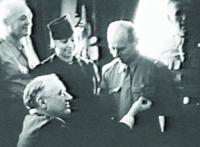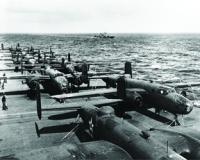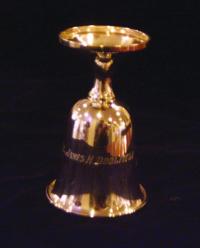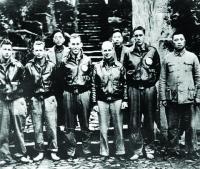
President Franklin Roosevelt. Behind Doolittle, l - r, are U.S.A.A.F. chief Hap Arnold, Doolittle's wife, and George Marshall.

B-25s on Hornet's flight deck, with light cruiser USS Nashville in background.

Doolittle Goblet

Jacket patch sewn into Raiders' clothing saying that they were friends and should be given every assistance.

Doolittle (ctr) and crew with Chinese rescuers. Copilot Cole stands on Doolittle's right.
In the weeks following the Japanese attack on December 7th, 1941,the United States was in shock. The fires on ships burned at Pearl Harbor still smoldered. The dead were still being recovered from sunken battleships. Something needed to be done to strike back. President Franklin Roosevelt charged his military to bomb Japan as soon as possible.
The Japanese considered themselves invulnerable on their island nation. The U.S.S.R., to the north and west, had signed a neutrality agreement with Japan in April of 1941. Korea and China to the south had been conquered. To the east were the vast Pacific and the Japanese Navy. The Japanese felt safe. The Americans needed to change that feeling to fear.
In order to strike the Japanese Home Islands, a long range aircraft with a large bomb load was needed. The mission requirements were for a range of 2400 nautical miles and a 2000 pound bomb load. Carrier aircraft had insufficient range and capacity. What was needed was a long range medium bomber. The problem was that no American or Allied land base was close enough to Japan. The solution was to find a land-based bomber that could be flown off of a carrier deck and had the range to reach Japan. Several aircraft were considered - the B-26 Marauder, B-18 Bolo and B-23 Dragon. The B-26 had poor takeoff performance on a short carrier deck and the B-18 and B-23 had such large wingspans that the number of planes that could be carried was insufficient. The B-25 Mitchell bomber was finally chosen, even though it had yet to be flown in combat.
The proposed mission, to fly land-based U.S. Army medium bombers off of a U.S. Navy aircraft carrier, had never been done before. In fact it has not been done since! The first test of this concept was on February 3, 1942. Two B-25 Mitchell bombers were hoisted by crane on the deck of the carrier Hornet in Norfolk, Virginia, and flown off of the deck without difficulty. The mission was approved. Lt. Colonel James Doolittle was selected to plan and command the mission.
The 17th Bomb Group was chosen for the mission which would be on a volunteer basis only. The crews were asked to volunteer for an extremely hazardous mission, but the purpose of the mission was kept secret. Twenty-four Mitchell bombers were sent to an aircraft modification and maintenance facility in Minneapolis, Minnesota. There the lower gun turret was removed, de-icing equipment was attached, extra fuel tanks were installed, almost doubling the fuel capacity, and perhaps most important, the Norden bombsight was removed. There could be no chance of the Norden bombsight falling into enemy hands. This would be a one-way mission. While the B-25 could take off from a carrier, it could not land on one.
The crews began training on March 1, 1942 at Eglin Field, Florida. They practiced taking off from a simulated carrier deck, over water navigation, and low level bombing. A U.S. Navy pilot, Lieutenant Henry Miller, supervised their training and is considered an honorary member of the group. On March 25, 1942, the planes were flown to California and on April 1, 1942, 16 aircraft were loaded aboard the aircraft carrier Hornet, at Alameda, California.
Each aircraft would carry a crew of five and a payload of four specially modified 500 pound bombs. Three of these bombs were high explosive and one was incendiary. An additional modification was the placement of fake gun barrels in the rear tail cone to discourage enemy fighter attacks.
The Hornet left California on April 2, 1942, and rendezvoused with Task Force 16, north of Hawaii. Task Force 16 was under the command of Vice-Admiral William Halsey, Jr., aboard the carrier Enterprise. The Task Force now consisted of two carriers, the Hornet and the Enterprise, three heavy cruisers, one light cruiser, eight destroyers and three fleet oilers. The fleet proceeded westward toward Japan maintaining radio silence. The carrier Enterprise would provide scouting planes and air cover as the Hornet could not launch or recover aircraft due to 16 B-25 bombers parked on her flight deck.
On April 17, 1942, the fleet was refueled and the oilers and destroyers withdrew to the east while the carriers and cruisers made a twenty-knot dash toward the take-off point off the coast of Japan.
The next morning the Task Force was spotted by a Japanese picket ship, No. 23 Nitto Maru, and a warning was radioed to Japan. The picket boat was sunk by gunfire from the light cruiser Nashville and five members of its crew were captured. The commander, a Japanese Navy petty officer, committed suicide to avoid capture. Due to the warning Lt.Col. Doolittle and the captain of the Hornet, Capt. Marc Mitscher, decided to launch the raid immediately even though they were 10 hours and 170 miles further away from Japan than planned.
Pilots manned their planes, engines were started and warmed up and 16 B-25 Mitchell medium bombers stood poised to launch. The take-off distance was 467 feet from where the first bomber was parked until the end of the flight deck. Doolittle took off first. Despite that none of the pilots ever having actually taken off from a carrier, including Doolittle, all 16 planes made it into the air.
The planes flew toward Japan, some 650 miles to the west. To avoid detection the planes flew at wave top level, approximately 100 feet above the sea. To further extend the range, 10 five-gallon gas cans were located in the rear of the aircraft and poured into one of the auxiliary fuel tanks by the radio operator as the gasoline was used. After approximately six hours of flight time, the Doolittle raiders arrived over Japan. It was noon, Tokyo time. Ten aircraft bombed military and industrial targets in Tokyo. The remainder hit targets in Yokohama, Yokosuka, Nagoya, Kobe and Osaka.
Despite several hours warning, the Doolittle raiders were able to reach and bomb their targets in Japan. Only one aircraft was damaged slightly by anti-aircraft fire and none were shot down. Fifteen of the planes now turned southwest toward the South China Sea and what they hoped were airfields in China. One B-25, being extremely low on fuel, turned northwest toward the Soviet Union, landing near Vladivostok where their aircraft was confiscated and they were interned by the Soviets. This crew was well treated and later transferred to Ashgabat - currently the capital, and largest city, of Turkmenistan - near the Iranian border where, on May 11, 1943, they "escaped" and made their way to the British Consulate in Iran. After the war it was revealed that the Soviet Secret Police, the NKVD, arranged for their "escape," as the Soviets could not release them legally due to their neutrality pact with Japan.
The remaining 15 planes now flew on toward China. It was getting dark, the weather was getting worse and they were running out of fuel. They soon realized that they could not make it to the airbases as they had planned. All either crash landed or bailed out over China. Doolittle bailed out and was saved from injury when he landed in something soft. Unfortunately it was a manure pile! Doolittle and his crew were helped by Chinese soldiers and civilians and an American Missionary, John Birch. At the time, Doolittle believed that his mission had been a failure. Due to the loss of all 16 planes and the minor amount of damage that had been inflicted on the Japanese, Doolittle believed he would be given a Court Martial upon his return to the United States. He received the Medal of Honor instead, and was promoted to brigadier general, skipping the rank of full colonel.
While the Doolittle raid inflicted relatively minimal damage, its repercussions were widespread. Three of the Doolittle raiders - Lt. Dean E. Hallmark, Lt. William G. Farrow and Sgt. Harold A. Spatz - who had been captured by the Japanese, were executed on October 15, 1942. In order to discourage the Chinese from helping downed American pilots a reign of terror was instituted over eastern China. It is believed that over a quarter of a million Chinese were murdered in reprisal.
The raid was a tremendous psychological and morale boost for America. American planes had bombed Tokyo, the first installment on the payback for Pearl Harbor. The Japanese Navy was called home to protect the homeland and five aircraft carriers under Admiral Chuichi Nagumo were sent back from operations against the British Navy in the Indian Ocean, to Japan.
The Japanese were also confused as to the manner of the attack. It was carried out in broad daylight by what were obviously land-based bombers. This confusion led the Japanese to believe that they were vulnerable to attack and led to Admiral Yamamoto’s decision to attack Midway Island in June of 1942, which resulted in a disastrous defeat for the Japanese Navy.
Since the Doolittle raid, the surviving raiders have met every April. They have a private ceremony in which they drink a toast from specially engraved silver goblets to the raiders who have passed away since the prior reunion. The goblets of the raiders who have died are then turned upside down. Each goblet is engraved twice with the name of a raider, right side up and upside down so that each man’s name can still be read. This past week, the Reunion was held at the National Museum of the U.S. Air Force at Dayton, Ohio. Present were the five remaining members: Lt. Col. Richard E. Cole, Doolittle’s copilot; Maj. Thomas C. Griffin, navigator on plane #9; Lt. Col. Robert L. Hite, copilot on plane #16; Lt. Col. Edward J. Saylor, engineer-gunner on plane #15; and Master Sgt. David J. Thatcher, Engineer-Gunner on plane #7. Additionally, spectators were treated to up to 25 B-25s flying in and landing at the airport.
NEXT: THE BATTLE OF THE CORAL SEA
«Go back to the previous page.




